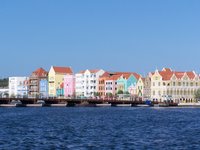About Curacao





Willemstad, the capital of Curacao was recognised in 1997 by Unesco and awarded with the world cultural heritage price: A picturesque, small but pulsating Metropolis where one can literally feel the eventful past of this town. Willemstad is located strategically on St. Anna Bay, a natural harbour and had to be defended by the Netherlands for over hundred of years from re-occurring attacks from the French, English and also from pirates. Although Willemstad is in the Caribbean, one has the feeling to be in some part of Europe, mainly due to the influence of Dutch architecture. Curacao offers indeed European standard to its visitors: the highest standard of personal security, low criminality, a good functioning municipality and drinking water of excellent quality.
This island is of multicultural society in the truest sense of the word. The inhabitants of the island stem from over 40 different nations and the majority of the Nationals stem from slaves. There are no conflicts between the various religions; Muslims, Christians and Jews, all present in large numbers, live peacefully together and without conflict. They are particularly gifted with languages: It is not a rarity to be able to speak four languages. Although Dutch is the official language, „ Papiamentu“ is mostly spoken, which derived from the influx of many different languages. The islanders are very proud of it.
Curacao has 444 km2, a lenght of 61 km and between 5 -14 km breadth. It is situated 70 km from Venezuela and 2 hours flight from Miami. 138.000 people are legally registered here. The island has a semi-arid savanna-like climate and lies outside of the hurricane belt. Curaçao flora is unlike the typical tropical island vegetation and is more akin to the Southwestern United States.
The origin of the name Curaçao is still under debate. One explanation is that it is derived from the Portuguese word for 'heart'. Another explanation is that Curaçao was the name the indigenous peoples of Curaçao had used to label themselves (Joubert and Baart, 1994). Their thesis is supported by early Spanish accounts, which refer to the indigenous peoples as "Indios Curaçaos". The Papiamento word for Curaçao is Kòrsou. The name "Curaçao" (in modern Portuguese Coração) has become associated with a particular shade of blue, and is sometimes used as an adjective, because of the deep-blue liqueur named "Blue Curaçao". (thx Wikipedia!)

0 Comments:
Post a Comment
<< Home